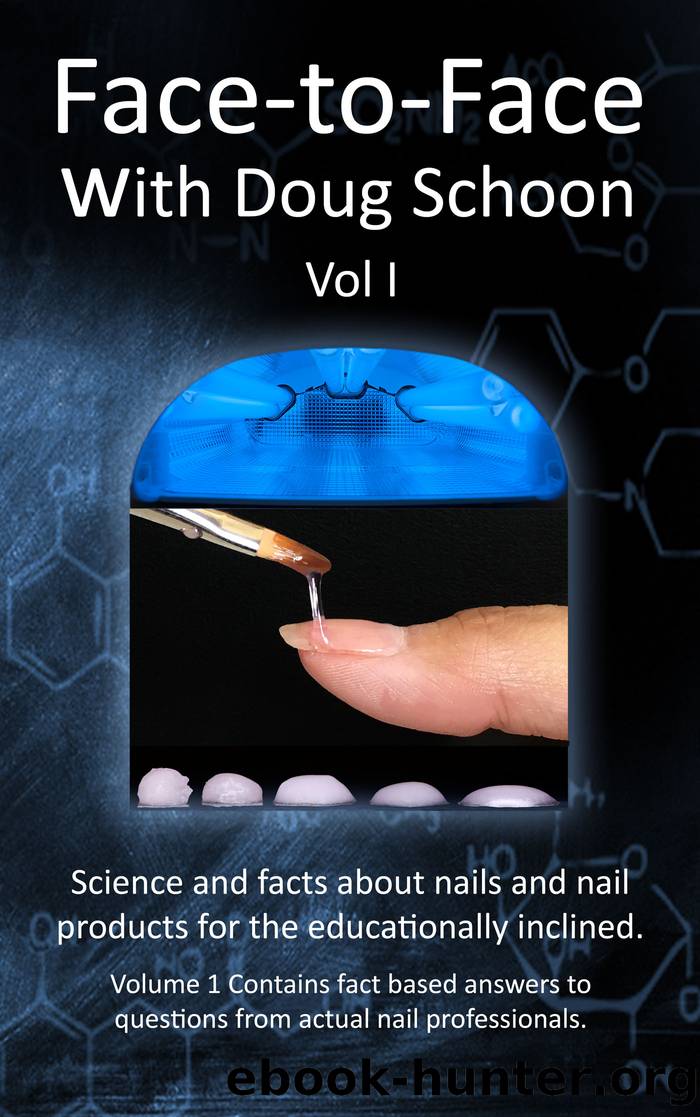Face-to-Face with Doug Schoon Volume 1 by Doug Schoon

Author:Doug Schoon [Schoon, Doug]
Language: eng
Format: epub
Published: 2016-07-15T00:00:00+00:00
Product/Service Quality and Safety
Section 6
5:1 What do you recommend is the ideal temperature and humidity for a salon?
It is ideal for salons to maintain a steady, comfortable temperature and humidity. Avoid wide swings in temperature- which can affect products. A good ideal range is between 68-78oF (20-23oC). It is comfortable working conditions and comfortable for clients, as well. Lower than 65oF (18oC) begins to affect cure and/or dry times, as does higher than 80oF. Cooler temperatures help improve products shelf-life and higher temperatures can shorten the useable life of products. Relative humidity (RH) is the measure of amount of water vapor in the air. 40-45% RH is generally considered comfortable in the temperature ranges mentioned above. Lower temperature and RH are less suitable for growth of common fungi and bacteria in the salon. 50-60% RH is considered average comfortable zone. Above 50%-60% RH and air begins to feel increasingly moist and higher than 70% RH promotes growth of fungi and bacteria. Dehumidifiers can be used, however, be sure to empty, clean and disinfect them regularly, as directed by the manufacturer. I recommend that salons empty and clean humidifiers daily and then clean and disinfect them weekly.
5: Nail Myth: Nails need to Breath.
Sorry, no they don’t and there is no evidence to support this silly notion. Here’s why: the nail plate isn’t alive and doesn’t have any lungs nor do they have any ability to absorb air into the nail plate. Nails do not require an external air supply and do not breathe nor do they exhale. Also, 100% of the oxygen needed by the nail matrix comes from the blood stream and 0% comes from the outside world. Everything the nail plate needs to properly grow and function is delivered and removed by the blood. When the nail plate is coated with any nail coating, including nail polish, moisture and natural nail oils will pass through the nail plate at slower than normal rates, but they aren’t “trapped”. The nail plate’s moisture content is increased by 10-15% and the natural oil content increases only slightly, e.g. 1-2%. Both oil and water in the nail plate serves to increase the flexibility of the natural nail plate.
Waste products are removed from the matrix and other tissues by the blood and are not released into the nail plate. Nail plates can grow and thrive in a completely air-free environment. All they need is a healthy flow of blood to the nail matrix, bed and surrounding tissue.
Clearly, nails don’t need to breathe for any reason. Those who say differently just don’t understand how the nails grow or function. Some marketers use such claims to fool nail technicians into thinking their products are better because they allow the nail to “breath”, but they don’t provide any evidence that this is useful. Claims that this improves the condition of the nails or prevents infections are unproven and in my view are false and misleading claims, until proven otherwise. I don’t recommend letting such claims influence your purchasing decisions.
Download
This site does not store any files on its server. We only index and link to content provided by other sites. Please contact the content providers to delete copyright contents if any and email us, we'll remove relevant links or contents immediately.
| Administration | Adult & Continuing Education |
| Business School Guides | College Guides |
| Financial Aid | Graduate School Guides |
| Law School Guides | Medical School Guides |
| Test Preparation | Vocational |
Navigation and Map Reading by K Andrew(4553)
Spare by Prince Harry The Duke of Sussex(4195)
Tuesdays with Morrie by Mitch Albom(3832)
Cracking the GRE Premium Edition with 6 Practice Tests, 2015 (Graduate School Test Preparation) by Princeton Review(3596)
What It Really Takes to Get Into Ivy League and Other Highly Selective Colleges by Hughes Chuck(3221)
Goodbye Paradise(2962)
Never by Ken Follett(2880)
Pledged by Alexandra Robbins(2790)
Kick Ass in College: Highest Rated "How to Study in College" Book | 77 Ninja Study Skills Tips and Career Strategies | Motivational for College Students: A Guerrilla Guide to College Success by Fox Gunnar(2720)
A Dictionary of Sociology by Unknown(2518)
Graduate Admissions Essays, Fourth Edition: Write Your Way into the Graduate School of Your Choice (Graduate Admissions Essays: Write Your Way Into the) by Asher Donald(2475)
Sapiens and Homo Deus by Yuval Noah Harari(2414)
Get into Any College by Tanabe Gen Tanabe Kelly(2384)
Zero to Make by David Lang(2348)
The Social Psychology of Inequality by Unknown(2310)
Machine Learning at Scale with H2O by Gregory Keys | David Whiting(2290)
500 Must-Know AP Microeconomics/Macroeconomics Questions(2240)
Fairy Tale by Stephen King(2069)
Will by Will Smith(2041)
